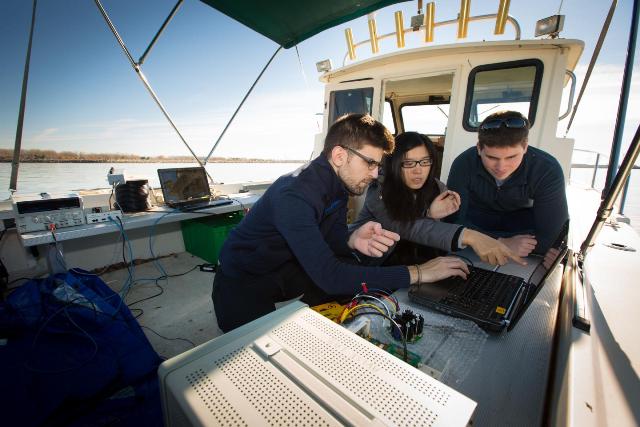Jan 27 2016
Like Beanie Babies and Steve Urkel, the systems we use to transmit information through water bring to mind the 1990s.
 University at Buffalo students test their underwater wireless network in Lake Erie. (credit: Douglas Levere, University at Buffalo)
University at Buffalo students test their underwater wireless network in Lake Erie. (credit: Douglas Levere, University at Buffalo)
The flashback is due to the speed of today's underwater communication networks, which is comparable to the sluggish dial-up modems from America Online's heyday. The shortcoming hampers search-and-rescue operations, tsunami detection and other work.
But that is changing due in part to University at Buffalo engineers who are developing hardware and software tools to help underwater telecommunication catch up to its over-the-air counterpart.
Their work, including ongoing collaborations with Northeastern University, is described in a study - Software-Defined Underwater Acoustic Networks: Toward a High-Rate Real-Time Reconfigurable Modem - published in November in IEEE Communications Magazine.
"The remarkable innovation and growth we've witnessed in land-based wireless communications has not yet occurred in underwater sensing networks, but we're starting to change that," says Dimitris Pados, PhD, Clifford C. Furnas Professor of Electrical Engineering in the School of Engineering and Applied Sciences at UB, a co-author of the study.
The amount of data that can be reliably transmitted underwater is much lower compared to land-based wireless networks. This is because land-based networks rely on radio waves, which work well in the air, but not so much underwater.
As a result, sound waves (such as the noises dolphins and whales make) are the best alternative for underwater communication. The trouble is that sound waves encounter such obstacles as path loss, delay and Doppler which limit their ability to transmit. Underwater communication is also hindered by the architecture of these systems, which lack standardization, are often proprietary and not energy-efficient. Pados and a team of researchers at UB are developing hardware and software -everything from modems that work underwater to open-architecture protocols - to address these issues. Of particular interest is merging a relatively new communication platform, software-defined radio, with underwater acoustic modems.
Traditional radios, such as an AM/FM transmitter, operate in a limited bandwidth (in this case, AM and FM). The only way to pick up additional signals, such as sound waves, is to take the radio apart and rewire it. Software-defined radio makes this step unnecessary. Instead, the radio is capable via computer of shifting between different frequencies of the electromagnetic spectrum. It is, in other words, a "smart" radio.
Applying software-defined radio to acoustic modems could vastly improve underwater data transmission rates. For example, in experiments last fall in Lake Erie, just south of Buffalo, New York, graduate students from UB proved that software-defined acoustic modems could boost data transmission rates by 10 times what today's commercial underwater modems are capable of.
The potential applications for such technology includes:
- Monitoring pollution.
- Military and law enforcement work; for example, drug smugglers have deployed makeshift submarines to clandestinely ferry narcotics long distances underwater. An improved, more robust underwater sensor network could help spot these vessels.
- The scuba industry; diver-to-diver walkie-talkies exist but their usefulness is limited by distance, clarity and other issues.
- The energy industry; an improved network could make finding oil and natural gas easier.